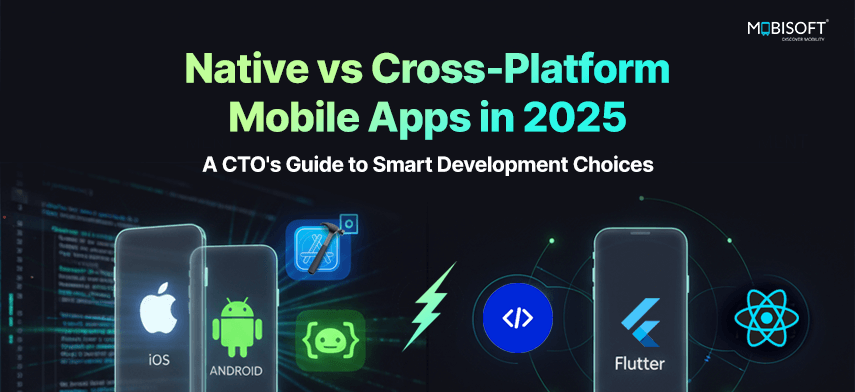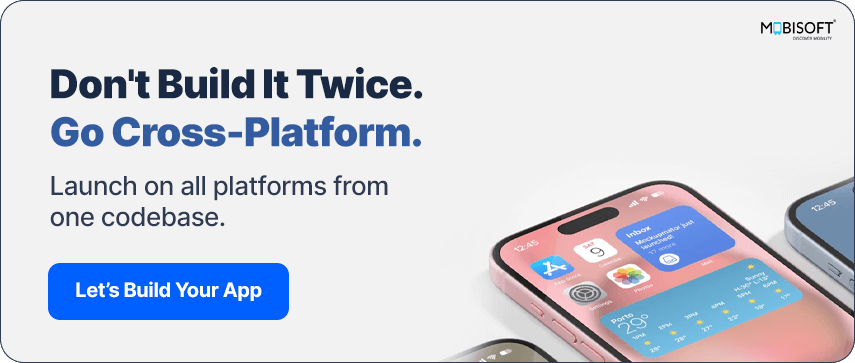Native vs Cross-Platform Mobile Apps in 2025: A CTO’s Guide to Smart Development Choices

The Changing Perspective of Mobile Apps
Since the invention of mobile applications in 1993, the industry has undergone immense changes. With the introduction of AI, the industry is under yet another important transformation. In 2023, people downloaded over 257 billion mobile apps globally. Experts expect mobile app development revenue to reach $613 billion by 2025. The mobile app development market was worth $475.90 billion in 2022. It is set to grow steadily and reach nearly $756 billion by 2027, with an annual growth rate of about 8.58% This fast growth shows how important mobile app development trends have become.
If you are a Chief Technology Officer, making smart choices about cross-platform vs native apps is crucial. This guide will explain both approaches in mobile app development 2025. It will cover their benefits, drawbacks, and which projects each suits best. Technological advancements keep users in anticipation. As a result, it is predicted that by the end of 2025, about 4.69 billion people will own smartphones worldwide. The best mobile app development strategies are therefore crucial to staying at the top.
How Native Apps Are Built with Modern Frameworks
Native apps are built specifically for one platform, either iOS or Android. Developers use languages unique to each platform. Swift is used in iOS, while Android is based on Kotlin. A key difference between these app types is the mobile app development tools needed to build native apps. iOS uses Xcode, Android has its own Android Studio, and those tools are highly specific to their use case, such as writing platform-specific code, handling resources, or making various types of interfaces.
Advantages of Native App Development
- Superior Performance and Speed: Native apps are created specifically for a platform, which means they are inherently faster and more responsive. They are built in consideration of the hardware, which makes them fully compatible.
- Access to Device Features: Native apps must ask permission to use device features such as the camera, GPS, or push notifications, which are built in without asking permission. This creates richer, more interactive apps.
- Enhanced User Experience: Native apps follow platform design principles, so they are authentic in feel and look to the user. This authenticity makes it more enjoyable and convenient to use them.
Explore the Best mobile app development services to build high-performance native apps.
The Trade-Offs of Native Apps
- Higher Development Costs: Different apps on iOS and Android require two codebases and, in many instances, two teams. Mobile app development costs can be as low as $40,000 for a basic app, up to over $400,000 in complex, enterprise-wide efforts. iOS app development in 2025 costs between $55,000 and $500,000. Android development falls in a band from $50,000 to $500,000.
- Longer Time to Market: Multiple app maintenance takes time, costs more money, and can even cause launch delays. Competitive markets don’t allow for such risks..
- Resource Demands: In-house native app development involves larger groups of testers, designers, and developers. That generates overhead and complexity. Annual maintenance generally runs 15 to 20 percent of the initial development outlay.
When is Native the right choice?
Native development is particularly well-suited for applications that require high performance and complex functionalities, such as:
- Gaming Apps: Applications like Fortnite and Call of Duty Mobile employ native development in a bid to generate incredible graphics and smooth gameplay experiences.
- Complex Functionalities: Applications requiring heavy calculation or instantaneous data manipulation, as in Spotify (streaming music) or Instagram (editing and uploading photos), benefit greatly from native functionality.
Current Market Statistics
In 2023, Apple’s App Store earned $85.1 billion. Google Play brought in $47.6 billion. In 2022, Apple held half of global consumer app spending, while Google Play made up 27 percent. This revenue gap shows why choosing the best mobile app development platform is key in native development.
How Cross-Platform App Development Works?
Cross-platform app developers only need to code once, but it is capable of running the apps on multiple devices. This makes the whole process very efficient. Some well-known cross-platform frameworks are Flutter mobile app development, React Native app development, and Xamarin. The result is less development time and lower cost. Check out our Cross-platform app development services to save time and cost.
Cross-Platform Framework Statistics
The cross-platform development industry is increasing at a steady pace. Its value is likely to expand from USD 15.67 billion in 2025 to USD 42.60 billion in 2034. That is an 11.75 percent compound annual growth rate (CAGR). React Native app development is at the second spot, since 32 percent of the developers used it in 2024. Statista data shows Flutter mobile app development holds a 42 percent market share as compared to 38 percent by React Native.
Learn about React Native app development services to enhance cross-platform apps efficiently.
Advantages of Cross-Platform Development
- Cost-Effectiveness
A single codebase for all platforms means fewer production and maintenance costs. This attracts small firms and business start-ups. The mobile app development cost falls in the range of $40,000 and $300,000. The cost of cross-platform app development in React Native is 25 to 50 percent lower compared to native development. At times, cross-platform software drops costs by 50 percent and releases the apps into the marketplace 1.5 times earlier.
- Faster Development Time
They can reuse 90 percent of the code on both iOS and Android. This reduces costs by as much as 30 percent and accelerates the app development lifecycle. The teams can expedite new features without duplicated efforts.
- Easier Maintenance
Apps with cross-platform app development have a shared codebase. This means that updates are reflected on all platforms at once, making them faster and affordable.
Read More: https://mobisoftinfotech.com/resources/blog/mobile/native-vs-cross-platform-apps-2025-ctos-guide
- AI
- Vitamins
- Health
- Admin/office jobs
- News
- Art
- Causes
- Crafts
- Dance
- Drinks
- Film
- Fitness
- Food
- Spiele
- Gardening
- Health
- Startseite
- Literature
- Music
- Networking
- Andere
- Party
- Religion
- Shopping
- Sports
- Theater
- Wellness



